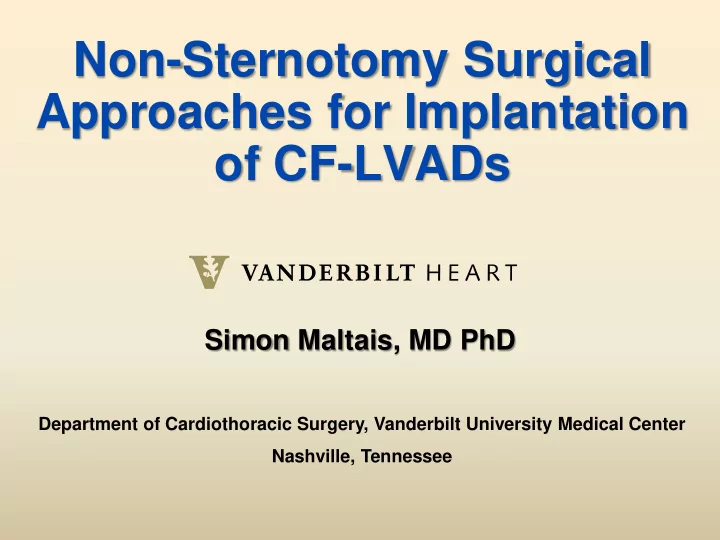

Non-Sternotomy Surgical Approaches for Implantation of CF-LVADs Simon Maltais, MD PhD Department of Cardiothoracic Surgery, Vanderbilt University Medical Center Nashville, Tennessee
Disclosures • Will discuss off-label use of the Heartware LVAS • Research Funding and Clinical Trial Educator (SM) • American Heart Association • HeartWare MCSRN
One Size Fits All?
Where Was it Implanted?
Right Operation for the Right Patient • Avoid extensive dissection with reoperations, decrease risks of cardiac injury • Shorten implant, facilitate inflow positioning, reduce CPB time • Avoid sternotomy or multiple reentries for patients undergoing heart transplantation • Decrease blood product requirements and sensitization • Preserve RV dysfunction through preservation of pericardial function?
Growing Experience with Alternative Strategies Hetzer, Ann Thorac Surg, 2004 • Selzman, J Card Surg, 2007 • Schmitto. J Am Coll Cardiol, 2010 • Anyanwu , Semin Thorac Cardiovasc • Surg, 2011. Borovic, JHLT, 2011 • Popov, Ann Thorac Surg ,2012 • Cheung, Ann Thoracic Surg, 2011 • Schmitto, J Thorac Cardiovasc Surg, 2012 • Mohite, J Thorac Cardiovasc Surg, 2012 • Sabashnikov , Expert Review Medical • Devices, 2013 Riebandt J Ann Thorac Surg 2013 • Duese, ASAIO Journal, 2014 • Haberla, Eur J Cardo Thorac Surg, 2014 • Maltais, ACS, 2014 • Maltais, JHLT 2015 • 2008 2009 2010 2011 2012 2013 2014
Surgical Approaches • ON -pump or OFF -pump when suitable • Inflow – Median sternotomy – Minimally invasive left thoracotomy – Subcostal diaphragmatic approach
Surgical Approaches • Ouflow – Ascending aorta • Full or partial upper hemi-sternotomy – Descending aorta • Single incision left thoracotomy – Left subclavian artery • Left axillary approach
Left Thoracotomy Implants Maltais, Operative Techniques in Thorac and CV Surgery, 2015
Contraindications for LT • Concomitant valve interventions • AV, TV, MV, PFO? • Mechanical AV • Severe RV dysfunction? • Left atrial thrombus Maltais, ACS, 2015
Thoracotomy Level Maltais, Operative Techniques in Thorac and CV Surgery, 2015
Coring and Positioning Maltais, Operative Techniques in Thorac and CV Surgery, 2015
Maltais, Operative Techniques in Thorac and CV Surgery, 2015
OFF-Pump? • Reduce Inflammation and coagulopathy associated with cardiopulmonary bypass • Reduced blood product transfusions • Avoid aortic and venous cannulation with their potential complications • Right heart protection? • Reduce cost?
OFF-Pump Strategy? • ACT always above 350 • Adenosine (30mg X 2) to induce short bradycardia asystole, allows LV coring and pump placement – Decreases arterial pressure – Lowers heart rate – Pulmonary vasodilatation Pelleg A et al. (1990) The pharmacology of adenosine. Pharmacotherapy 10: 157-174
Early Perioperative Outcomes All LT CS P value n=81 n=27 n=54 ICU LOS (days) 8 ±10 10 ±12 9 ±9 0.62 Total LOS (days) 15 ±9 15 ±11 15 ±9 0.85 RVAD (%) 4 0 6 0.22 Dialysis (%) 12 19 9 0.23 OR Blood Products (U) 6 ±10 6 ±5 8 ±112 0.04 Total Blood Products (U) 12 ±18 9 ±16 14 ±18 0.11 Time on MV (days) 4 ±9 4 ±8 4 ±9 0.04 Inotrope duration (days) 7 ±8 6 ±7 7 ±8 0.22 30-day mortality (%) 1 0 2 0.98 Follow-up Time (years) 0.6 ±0.4 0.5 ±0.3 0.6 ±0.5 0.96
Clinical Outcomes All LT CS P value n=81 n=27 n=54 Ischemic CVA (%) 3 2 1 0.28 Hemorrhagic CVA (%) 1 0 1 0.49 TIA (%) 3 1 2 0.97 GI Bleeding (%) 9 8 6 0.57 Driveline infection (%) 2 1 2 0.61 Other infections (%) 6 4 6 0.57 RV failure, RVAD (%) 4 0 6 0.22 Thrombus/hemolysis (%) 1 0 2 0.49 Readmission (#) 1.0 ±1.3 0.9 ±1.3 1.0 ±1.3 0.41 Cardiac Readmit (#) 0.3 ±0.6 0.2 ±0.5 0.3 ±0.7 0.72 N-Cardiac Readmit (#) 0.7 ±1.2 0.7 ±1.1 0.7 ±1.1 0.62 Follow-up Time (years) 0.6 ±0.4 0.5 ±0.3 0.6 ±0.5 0.96
Survival Analysis
Descending Anastomosis • Surface echo: identify LV apex and perform 6cm left thoracotomy • Femoral access for CPB if needed • OFF-pump outflow graft anastomosis to descending aorta using 4-5cm piece of outflow graft – pulmonary ligament detached for better exposure, anastomosis performed near diaphragmatic junction • OFF-pump attachment of sewing ring to LV apex and tunneling of driveline through subxiphoid counter incision • ON-pump or OFF-pump LV coring and pump implant • End-to-end anastomosis with hemashield graft and deairing
Maltais, Operative Techniques in Thorac and CV Surgery, 2015
Left Subclavian Anastomosis • LVAD flow to left upper extremity and cerebral vasculature with backflow to systemic circulation – Increases forward flow and native ejection • Implications – Left upper extremity hyperemia and edema • Technical considerations for anastomosis • Arterial flow to LUE restricted (banded) • TED hose on LUE x 10 days postop • Elevate LUE to improve venous return – Blood pressure always assessed on right side
Left Subclavian Anastomosis Maltais, Operative Techniques in Thorac and CV Surgery, 2015
Left Subclavian Anastomosis Maltais, Operative Techniques in Thorac and CV Surgery, 2015
Left Subclavian Anastomosis Maltais, Operative Techniques in Thorac and CV Surgery, 2015
Partial vs Complete Support (Redo Sternotomy) Conclusions: • Partial support, sternal- sparing approach to HVAD placement is feasible and safe for BTT • Application for prior sternotomy patients • Similar early mortality and adverse events as complete support
The Times They Are-a-Changin’ (Bob Dylan, 1964) • Learn the basics first… • Alternative LVAD implant techniques may have advantages in specific patient populations • Medication and device management should be personalized and tailored to pump implant strategy to maximize pump performance and minimize complications • Indications for alternative approaches and implications for long-term management require further investigation
Recommend
More recommend